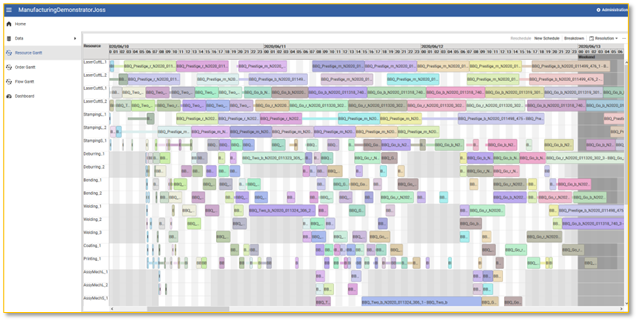How to Tackle Complex Scheduling Issues in Production Planning
Nancy Sarpolis - November 15, 2022

An automotive manufacturer was recently faced with the challenge of adding capacity in the form of two new vehicle production lines, four engine and axle lines, and an additional line for interior components. Developing the production schedule for the new lines was just as demanding: Each line specialized in different order types, had separate throughput times per order and used a variety of process flows. Special orders—which were common—also needed to be comprehended in the production schedule.
Production planning via spreadsheet met its match.
Complex scheduling requirements need automated technologies such as Advanced Planning & Scheduling (APS) solutions. APS uses a variety of interconnected modules to look at the relationship between sales and production (Order Slotting & Scheduling), plant capabilities (Detailed or Job Shop Scheduling), and the optimal short-term schedule to maximize production efficiency (Sequencing).
In this blog post, we’ll focus on Detailed Scheduling.
How Detailed Scheduling Works
Detailed Scheduling brings together the components needed to effectively manage the flow of a product through all types of production facilities. Assembly lines, for example, typically run a number of machines in succession. In a job shop, a set of machines can be used in multiple combinations depending on what part or product is being produced. The same set of machines might be used in a different order to create different elements of the same engine, for example. The variety of uses for each machine helps businesses to maintain flexibility on their production floor, but it also creates potential optimization issues
Agile planning solutions allow planners to identify specific parameters, constraints and capabilities for every piece of equipment, regardless of whether it’s an assembly line or a job shop. The parameters provide a “roadmap” for the automated planning tool to follow as it searches for the optimal “path” for each product. Parts requirements, line speed, run rates and other factors can all be comprehended in the system, as well as scheduled downtime for planned maintenance or upcoming holidays that will impact staffing levels.
Once orders are received, the automated Detailed Scheduling solution looks at the requirements for each order, compares it to the parameters, capabilities and constraints for each piece of equipment in the process—as well as the requirements for other orders in the pipeline—and ensures that jobs are scheduled on the right machinery, at the right time and with the right resources.
Pathway to a more efficient production schedule
A crucial part of balancing and smoothing production flows on an ongoing basis requires knowing the status of shop floor operations at all times. Without digital scheduling technologies, planners are stuck gathering data from disparate machines, spreadsheets and other sources to cobble together production plans. Detailed Scheduling solutions bring the data to them by providing a dashboard with a comprehensive view of every machine, product, and process.

Being able to get instantaneous data and alerts on weight, maintenance time, operating hours or errors that have occurred from radio frequency identification (RFID) units, robots, grippers and other devices directly into the planning platform can help planners recognize potential bottlenecks at an early stage. Schedule changes can be adjusted on-the-fly. And, as hurdles and disruptions arise, production programs can be reworked to meet customer demands.
Adding even more value
Planners looking to add even more value can opt for scheduling solutions that seamlessly transfer data from the planning area to the execution area and vice versa. Technologies that interwork easily with existing MES and ERP systems can also add improved functionality. And, cloud-based APS solutions provide even more flexibility, letting supply chain planners manage capacity in a dynamic way or employ a central solution that interworks easily with Microsoft Azure, AWS or popular suppliers of cloud services.
For production planners who need to make sense of complex scheduling requirement, the answer is clear: Step away from the spreadsheets. Detailed scheduling solutions can be the answer to an efficient, effective, dynamic production plan.
If you want to learn more get your Guide to Production Planning
In this Guide you will learn:
-
How to build resilience
-
How to increase efficiency
-
How to use integrated APS planning services for production planning
-
What must-have features of an APS solution you need
-
Which KPI’s you can expect
LATEST POSTS
- Understand Circular Economy in The Manufacturing Industry
- How Can Industry 4.0 IT Integration Be Achieved Smoothly?
- The Significance of Order Sequencing in Discrete Manufacturing
- How to improve your Supply Chain Management: The Power of Control Towers
- Optimizing Human Resource Scheduling in Manufacturing: A Technological Approach



